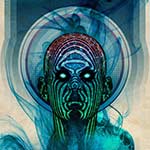| Author
|
Sample Rate question
|
Dylan89
IsraTrance Junior Member

Started Topics :
11
Posts :
24
Posted : Feb 4, 2013 23:30:16
|
|
knocz
Moderator

Started Topics :
40
Posts :
1151
Posted : Feb 5, 2013 00:38
|
48 000 Hz (aka 48 kHz) is a higher sampling rate than 44 100 Hz (aka 44.1 kHz), so the analog sound wave is sampled at a higher rate, and the I/O converters can reproduce the original wave with higher fidelity. Usually this means 48 kHz is better than 44.1 kHz.
According to DSP theory, you can successfully reproduce frequencies up to half of your sample rate, so 44.1 kHz / 2 = 22.05 kHz. As humans hear only up to 20 kHz, 44.1 kHz is more than sufficient to have high quality sound and all of your audible frequencies reproduced.
The thing where you really notice this is of your start stretching your sound. Let's say you make it twice slower, than with a sample rate of 44.1 kHz, you will only have 22 050 samples a second (or Hz), and according to the DSP you can only reproduce frequencies of up to 10 025 Hz. That is way in our hearing range.
If you use a higher sampling rate, than you can slow it down and hear the supersonic frequencies come in -> sampling at 192 kHz is perfect for this.
Now, 48 kHz is usually used in movies and 44100 in cd's. Of my knowledge there's not much of a particular reason why those particular values, but there ought a be something..
Conclusion: set it as high as you can get it, as long as your machine can handle it 
        Super Banana Sauce http://www.soundcloud.com/knocz Super Banana Sauce http://www.soundcloud.com/knocz |

|
|
Upavas
Upavas

Started Topics :
150
Posts :
3315
Posted : Feb 5, 2013 01:33
|
|
knocz
Moderator

Started Topics :
40
Posts :
1151
Posted : Feb 5, 2013 06:23
|
Quote:
|
On 2013-02-05 01:33, Upavas wrote:
Bullshit! This has been discussed ad nausea. 44.1 is the best, because it is widely used today. 48khz is best if you sample for movies, and even in the movies music gets resampled from 44.1khz to 48khz sampling rate. Just make sure to set a lowpass filter at around 20khz frequency, that's all, nothing else is needed!
To find out more about this subject please check out this link, pay attention to the section about aliasing...
http://en.wikipedia.org/wiki/Nyquist%E2%80%93Shannon_sampling_theorem
You cannot hear anything above 20khz frequency, period!
|
|
Yeah man exactly as the link says:
"In other words, a bandlimited function can be perfectly reconstructed from an infinite sequence of samples if the bandlimit, B, is no greater than ˝ the sampling rate (samples per second)."
You'll need at least 40 kHz in order to reproduce a analogue signal of 20kHz, and the extra 4.1kHz in 44.1 is a little over head.
But if you think a bit, if you lower the speed of an audio file, you are playing less samples per second, effectively lowering your sample rate.
And if you learn about aliasing, you'll find out it's artificial artifacts that are introduced by the sampling: the lower the sampling, the higher the aliasing. Higher sample rates can catch higher frequencies, and when slowed down you can hear those frequencies.
Also, 44.1 kHz is mainly used in consumer format, many producers use what they like according to their audio uses.
        Super Banana Sauce http://www.soundcloud.com/knocz Super Banana Sauce http://www.soundcloud.com/knocz |

|
|
Alien Bug
IsraTrance Junior Member

Started Topics :
27
Posts :
682
Posted : Feb 5, 2013 11:57
|
|
PoM
IsraTrance Full Member

Started Topics :
162
Posts :
8087
Posted : Feb 5, 2013 12:06
|
44,1
48khz dont make much sense for music.. depending the soundcard 48 khz might be a lil better i think cause of how the anti aliasing filter react but it won t change munch..
for synth and processor 44,1 or 48khz is mostly the same in term of aliasing, you have to go 88,2 or 96khz to have a little benefit but lot of today plug oversample internally when it s needed or deal with aliasing in other way.. with these plug using 96 khz won t make much difference except taxing your cpu double time..
|

|
|
Alien Bug
IsraTrance Junior Member

Started Topics :
27
Posts :
682
Posted : Feb 5, 2013 12:12
|
|
PoM
IsraTrance Full Member

Started Topics :
162
Posts :
8087
Posted : Feb 5, 2013 12:32
|
Quote:
|
On 2013-02-05 12:06, PoM wrote:
for synth and processor 44,1 or 48khz is mostly the same in term of aliasing, you have to go 88,2 or 96khz to have a little benefit but lot of today plug oversample internally when it s needed or deal with aliasing in other way.. with these plug using 96 khz won t make much difference except taxing your cpu double time..
|
|
with lot of plugs it won t make much difference but with some plugs (i think more older one ) can sound different depending the sample rate.. and in these case 88,2 or 96 khz might be better.. ( maybe better filter response, better fast modulation like fm on a synth for example,sometimes i think i noticed brigther synth sound maybe cause of strange anti aliasing filter behavior dunno..) |

|
|
Fungophago

Started Topics :
9
Posts :
81
Posted : Feb 5, 2013 16:45
|
basically it works like this: the higher the sampling frequency the better the signal.
lets say you have a signal h(t)=sin(t) (simple sine wave , no consideration of higher modes).
when you look at this funktion at a frequency of of t=pi and start at t=0 you will read out 0,0,0,0 and so on.
http://www.wolframalpha.com/input/?i=h%28t%29%3Dsin%28t%29
so you cant reconstruct the signal.
if you do the same with a frequency of pi/2 you will read : 0,1,0,1 ...
you will reconstruct a triangle wave (if you connect the dots in the graph).
if you look at a frequency of t=pi/4 the reconstructed waveform beomes closer and closer to the original signal.
mathematicly you would want a sampling rate of t=pi/infinity.
i forgot to mention frequency f=1/t.
your computer cant realise such, so you have to make a compromise.
cd quality standart is 44,1khz with the highes recontructable frequency of about 20khz.
i use that for my productions, because it will be broken down to that frequency anyway, the cpu load is less and 20khz and above is only terror for my dog 
if you want a more detailed discussion read
koenigsberger "funktiontheory"
and
arild lacroix "digital filters"
cheers |

|
|
maxee
Started Topics :
1
Posts :
8
Posted : Feb 5, 2013 17:20
|
Quote:
| You cannot hear anything above 20khz frequency, period! |
|
I once read an interview with walter sear and he stated: audio information from sources like a microphone carrys a lot of information above 20 kHz and we are actually able to hear all the subharmonics resulting from that.
what you guys think?
|

|
|
Alien Bug
IsraTrance Junior Member

Started Topics :
27
Posts :
682
Posted : Feb 5, 2013 17:27
|
|
Alien Bug
IsraTrance Junior Member

Started Topics :
27
Posts :
682
Posted : Feb 5, 2013 17:30
|
Quote:
|
On 2013-02-05 17:20, maxee wrote:
Quote:
| You cannot hear anything above 20khz frequency, period! |
|
I once read an interview with walter sear and he stated: audio information from sources like a microphone carrys a lot of information above 20 kHz and we are actually able to hear all the subharmonics resulting from that.
what you guys think?
|
|
in maximum short: we dont hear this frequencies above (and below) but they affect the audible frequencies.
this is interesting question for longer debate
        http://www.beatport.com/release/cross-the-atoms/1042450 http://www.beatport.com/release/cross-the-atoms/1042450
http://soundcloud.com/alien-bug
http://www.facebook.com/ali3nBug |

|
|
PoM
IsraTrance Full Member

Started Topics :
162
Posts :
8087
Posted : Feb 5, 2013 18:15
|
|
Upavas
Upavas

Started Topics :
150
Posts :
3315
Posted : Feb 5, 2013 21:34
|
Quote:
|
On 2013-02-05 17:30, Alien Bug wrote:
Quote:
|
On 2013-02-05 17:20, maxee wrote:
Quote:
| You cannot hear anything above 20khz frequency, period! |
|
I once read an interview with walter sear and he stated: audio information from sources like a microphone carrys a lot of information above 20 kHz and we are actually able to hear all the subharmonics resulting from that.
what you guys think?
|
|
in maximum short: we dont hear this frequencies above (and below) but they affect the audible frequencies.
this is interesting question for longer debate
|
|
Once again, there is nothing to affect, because what is being affected your ear can't hear. A lowpass filter around 20.000hz frequency and the result is just the same, exactly the same to our ears!!! Someone noted a comparison with mine is bigger than yours. Exactly true, higher sampling rates in sound cards are nothing but marketing strategy!
        Upavas - Here And Now (Sangoma Rec.) new EP out Oct.29th, get it here: Upavas - Here And Now (Sangoma Rec.) new EP out Oct.29th, get it here:
http://timecode.bandcamp.com
http://upavas.com
http://soundcloud.com/upavas-1/ |

|
|
knocz
Moderator

Started Topics :
40
Posts :
1151
Posted : Feb 5, 2013 21:46
|
Quote:
|
On 2013-02-05 21:34, Upavas wrote:
Once again, there is nothing to affect, because what is being affected your ear can't hear. A lowpass filter around 20.000hz frequency and the result is just the same, exactly the same to our ears!!! Someone noted a comparison with mine is bigger than yours. Exactly true, higher sampling rates in sound cards are nothing but marketing strategy!
|
|
Sorry man, but it can affect the signal in many ways. Learn about dsp, understand how frequencies are derived, and you'll see it.
And changing the speed of the recording will affect gravely on the sample rate, at it changes the sample rate. If you take something at 30 kHz and play it at half speed, than the 30 kHz will become 15 kHz, which is audible. Play it at quarter speed and you hear a lot more.
        Super Banana Sauce http://www.soundcloud.com/knocz Super Banana Sauce http://www.soundcloud.com/knocz |

|
|